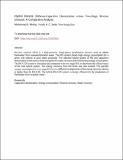| dc.contributor.author | Minhas, Muhammad | |
| dc.contributor.author | Jande, Yusufu | |
| dc.contributor.author | kim, Woo-Seung | |
| dc.date.accessioned | 2020-04-02T07:46:51Z | |
| dc.date.available | 2020-04-02T07:46:51Z | |
| dc.date.issued | 2014-06-06 | |
| dc.identifier.uri | https://doi.org/10.1002/ceat.201300681 | |
| dc.identifier.uri | https://dspace.nm-aist.ac.tz/handle/20.500.12479/707 | |
| dc.description | This research article published by John Wiley & Sons, Inc., 2014 | en_US |
| dc.description.abstract | Reverse osmosis (RO) is a high‐pressure single‐phase desalination process used to obtain freshwater from seawater/brackish water. The RO system shows high energy consumption for a given unit volume of pure water produced. The reported hybrid system of RO and capacitive deionization (CDI) aims at improving the RO water recovery and minimizing energy consumption. The RO‐CDI system is simulated and compared with two‐stage RO, to determine the effectiveness of the new hybrid system. The energy recovery from RO brine was also studied. The specific energy consumption by two‐stage RO for two different arrangements of the energy recovery device is higher than for RO‐CDI. The hybrid RO‐CDI system is energy efficient for the production of freshwater from brackish water. | en_US |
| dc.language.iso | en | en_US |
| dc.publisher | John Wiley & Sons, Inc. | en_US |
| dc.subject | Capacitive deionization | en_US |
| dc.subject | Energy consumption | en_US |
| dc.subject | Reverse osmosis | en_US |
| dc.subject | Water recovery | en_US |
| dc.title | Hybrid Reverse Osmosis‐Capacitive Deionization versus Two‐Stage Reverse Osmosis: A Comparative Analysis | en_US |
| dc.type | Article | en_US |

